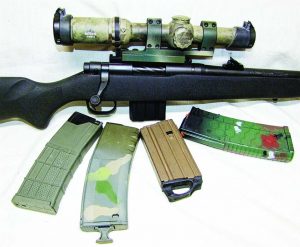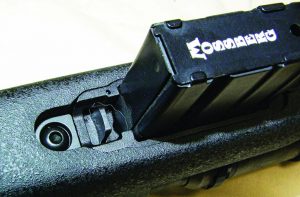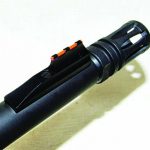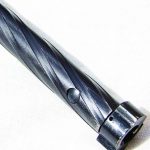by Scott Smith | Contributing Editor

The Mossberg MVP Patrol resting on an MTM Site-N-Clean with the test ammunition from Black Hills, Hornady and Nosler.
A couple of years back Mossberg (Phone: 203-230-5300; Online: mossberg.com) introduced the MVP Patrol. This rifle was initially available chambered in .223 Remington and, about a year later, a .308 Winchester version was offered. These rifles are both lightweight rifles; the .223 version weighs seven pounds, while the .308 tips the scales are seven and half pounds. The weight of these rifles is what makes them desirable for hunters, especially if you are a hunter who stalks or, by nature of the terrain, must walk long distances.
The sample I received was chambered in .223 because I needed a handy mid-range varmint rifle and my suppressor is for .223s. Where I hunt is in the hilly farmlands of southwest Pennsylvania, so I did not want to be packing a heavy rifle. I did want a rifle that was accurate with most common weights of bullets. With its 1 in 9 twist rate this rifle should accurately launch bullets from 40 to 62 grains without issue.
Before we head out to the range, let’s take a look at the details of the MVP Patrol. The most important feature of the MVP family of rifles is the Lightning Bolt Action. This includes a user adjustable trigger which can be adjusted from three to seven pounds. A crisp light trigger that will not affect ignition reliability aids greatly in accuracy.
Next is the fluted bolt. This reduces weight without sacrificing strength. It also helps clear debris when you are in harsh environments. This might sound crazy but high deserts can bind up actions just like snow and ice can. This helical fluting will drastically reduce the odds of this happening.
While most of us prefer optics, if you are old school and use “iron” sights you will approve of the sights Mossberg installs on the MVP Patrol. They are a modified buckhorn rear and fiber optic front. For snap shots, this combination is fast and accurate.
For those of us who prefer optics you will find a solid Picatinny rail to secure your choice of optics. I mounted a number of different military spec and civilian mounts and all were rock solid. This can be attributed to the rises and valleys of the rail all being square and true. This is why getting a mil-spec Picatinny rail is preferred over a Weaver rail which is not as exacting. It is a good rail but when the tops of the rises are more rounded your mount can shift. For this reason, if you are using a larger bore of magnum caliber, make sure the cross bars of a mount are truly square, not rounded or beveled corners.

This shows the Millett 1-4 DMS with magazines from Lancer( L), Troy Industries, Brownells and HexMag (R); the rifle performed flawlessly with all of them.
Both the .223 and .308 rifles ship with 11-round box magazines of the AR design. The .308 will also accept M1A/M14 magazines, so you should not have an issue finding something to keep your rifle charged. Before you decide to use your favorite 30-round magazine to hunt with, check your state regulations. Most states limit hunting rifles to five rounds or less. If you cannot find five-round magazines, you can easily block AR and M1A magazines to meet state requirements. Again, check the regulations of your state before doing this. I really do not want to be explaining to such and such a state game commission that I said it was okay; I DID NOT.
For the initial trip to the range I gathered up several dozen rounds of .223. This collection was from several manufactures, of various weights and bullet designs. All I wanted to test was the smoothness of the trigger and bolt, and whether or not the rifle would feed from a variety of magazines. While running these rounds down range, I also shot it for accuracy at 50 yards with the factory sights. What I found was the MVP Patrol Rifle cycled smoothly and fed from all the magazines. Most importantly at 50 yards the rifle was placing this mixed bag of ammunition consistently into the “upper A” of a USPSA target. For those of you not familiar with this target that is a two inch by four inch box. The rifle did not drop one round out of the four by six upper A/B zone. I fired well over 100 rounds without missing the complete head and most in what would be the “X-ring”, that’s pretty good for iron sights.
With this kind of out of the box accuracy, I was looking forward to shooting the MVP Patrol with optics. To say it would be easy to put too much glass on a compact rifle would be an understatement. Since I have limited distance at my range to test the accuracy, I mounted a Millett (Phone: 800- 423-3537; Online: millettsights.com) 1-4 DMS. Over the years I have found this to be a good short to mid-range scope. If it was mounted on the .308Win version of the MVP Patrol, it would make a fine brush rifle ideal for stalking Whitetails throughout most of their natural range.

The magazine drops free whether it is the factory model in the photo or any aftermarket model; just push the release towards the magazine.
With the 1 in 9 twist I chose to shoot lighter weight .223s. This would allow the rifle to perform its best. I dug out a couple of loads from Black Hills (Phone: 605-348-5150; Online:black-hills.com) 62-grain TSX, Hornady (Phone: 800-338-3220; Online: hornady.com) 40 and 60-grain TAP, one from Nosler (Phone: 800-285-3701; Online:nolser.com) 55-grain Varmageddon and some military surplus 55-grain full metal jacket. This mix would be good to zero the Millet to the MVP Patrol and the Varmageddon load would be ideal for dispensing with a growing problem on local farms: coyotes. This was the primary reason for picking the .223 chambered Patrol, I could fit a Surefire muzzle brake for my Mini suppressor. It will be ideal for reducing this ever growing and destructive varmint problem.
I digress. It was time to get the rifle to the range and do some shooting. Since I had bore-sighted the rifle/scope before heading to the range I was confident that I would not be wasting time and burning through loads of ammunition. Happily I can report at 50 yards it was on paper the first shot and in the bullseye in two more. While the point of aim/point of impact changed with through the range of bullet weights it was less than a half inch at one hundred yards. This shows just how far ammunition and barrels have come since my youth when switching from a 55 grain bullet to one weighing 40 grains would have seen the impact move several inches. While I would want to truly zero every load to hunt with it, for range work, being able to shoot consistent tight groups is what was needed.

Close-up of the Mossberg factory-installed fiber optic front sight that can be seen in virtually all lighting conditions as well as the removable “A2” flash hider.
During the accuracy phase we found the Mossberg MVP Patrol to be a tack driver. Five shot groups fired from my MTM Case-Gard (Phone: 937-890-7461; Online: mtmcase-garc.com) Site-n-Clean rest at 100 yards were all sub one inch. When I moved out to 200 yards these groups hovered around two inches. I am certain with a more powerful optic this rifle would shoot sub MOA at this distance. Past experience with the .308 chambered version has shown this rifle capable of shooting incredible groups at 300 and 400 yards. As the Patrol sets it will more than adequately be able to help eradicate coyotes and ground hogs that happen to be in the field. If you go with the .308 MVP Patrol, you will have a handy rifle that is capable of bringing down the vast majority of large game in CONUS.

One of the keys to the MVP’s reliability in the nastiest of conditions is the fluted bolt.
One of the features that sets this rifle apart from others is the stock. First it is compact which will make it good for small statured hunters. The shorter size will also allow the rifle to fit better with bulky winter clothing. You will find the stock has a unique texture that gives you a solid purchase with gloves on or, in my case, when sweat is pooling in your hands on 90 degree days. Mossberg built the Patrol to be a serious use rifle.
With the MVP Patrol you can get an accurate quality rifle for $710, while the Millett DMS will set you back around $250 online. That’s a package that will last for years to come. If you want rifles that are more purpose built Mossberg offers other rifles in the MVP family or its more hunting-oriented Patriot line-up. Whether you are in need of a long range varmint rifle, quick handling brush gun or something in between; check out Mossberg; you won’t go wrong.
To be able keep your right to hunt and to bear arms, make sure you VOTE for candidates who support those rights; not for the best socialist according to the unions. Last remember to be safe, know your target and have fun in the woods.



